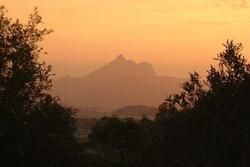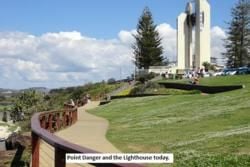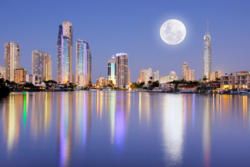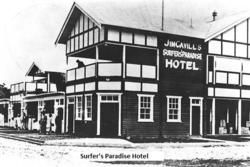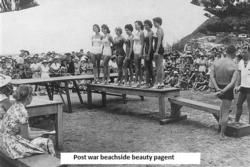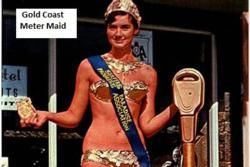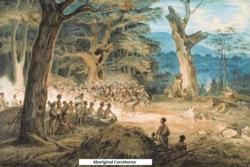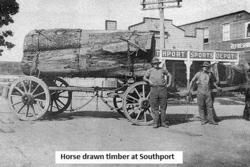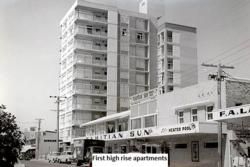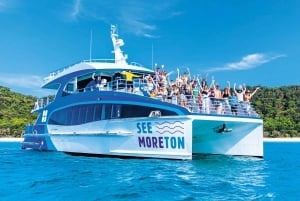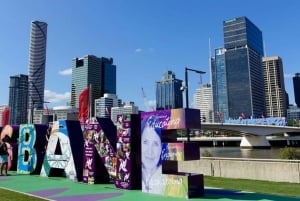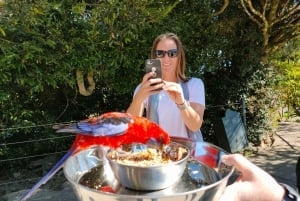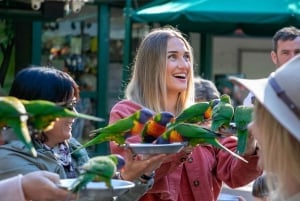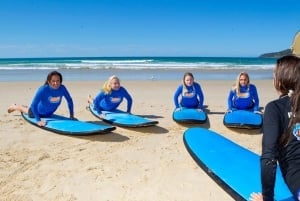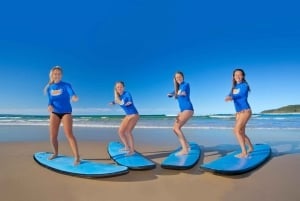History of the Gold Coast
Sunny paradise by the sea
The Gold Coast you will enjoy today is a vastly different City and region to even just 50 years ago let alone a time stretching beyond that. The City of today is very much a development of the last 50 or so years and is a stark contrast to its former self.
The "Dreamtime" of Paradise:
There is archaeological evidence to suggest that the Aboriginal people have inhabited the Gold Coast region for over 23,000 years or as far back as pre-historic times. The first residents and tourists were therefore Aborigines. The area was a part of the territory occupied and travelled by the Gombemberri tribe (a tribe of the Yugambeh people). Their homeland reached from the Tweed River in the south to the Coomera River in the north. From the coastal seaboard beaches it spread west to the foothills of Tamborine Mountain. They enjoyed the areas plentiful abundance of fresh water and huge variety of fresh foods. Their diet consisted of mussels, prawns, and dark green, leafy vegetables. There was honey in the hives of stingless native bees. The sea and waterways supplied them with fish, whilst creeks and estuaries supplied them with crayfish (yabbies), crabs and were also rich in oyster beds. Beaches had plentiful supplies of pippies and clams. Flocks of wild ducks and other waterbirds covered the swamps and lagoons; plump birds such as parrots, pigeons and scrub turkeys, were plentiful in the woodlands. The inland forests with their abundant animal life were also a source of edible roots, yams, and all manner of fruit, berries and nuts (over 20 different kinds including the Macadamia). The area was well known for great feasting and corroborees. They lived in the hinterland during the summer and the beaches during the winter – and avoided the mosquitoes of the coastal swamps.
They were a happy, peaceful people, and their rich food supplies were reflected in their physiques. Along with the Tweed River blacks they were giants among the Aborigines and have been described as among the most physically and intellectually developed of Australia's First People. The region was also popular with other tribes from far away. They would visit the Gold Coast for festivals, tribal ceremonies, fishing, subtropical fruits and bush tucker and to harvest a special hardwood that they used to make boomerangs.
European settlement:
The Queensland coastline first appeared on maps in Europe during the reign of the English King Henry VIII between 1509 – 1547. The Gold Coast region was first sited by Captain James Cook (Royal Navy) during his "Voyage of Discovery" in 1770. He did not land in the area but named Mt Warning and Point Danger. In 1799 Captain Mathew Flinders landed on the coast and was probably the first European to stand on a local beach. John Oxley in 1823 discovered and named the Tweed River and also landed on the coast. Mermaid Beach is named after his cutter Mermaid. In 1828 a military post was established at Point Danger and became the first European settlement on what is today know as Tweed/Gold Coast.
In 1840 the New South Wales government surveyors chartered the area and this in turn brought the region to the attention of early European settlers. In 1846 the Schooner Coolangatta was wrecked off Coolangatta and the town of Coolangatta was later named after it. The hinterland's supply of red cedar began drawing timber cutters to the region in large numbers in the mid-19th century and in 1865 the inland township of Nerang (named after the local aboriginal word "neerang", meaning ‘shovel-nosed shark’) was surveyed and established as a base for the industry. Eight people applied for allotments in this new township. The surrounding valleys and plains were quickly developed as cattle, sugar and cotton farms and by 1869 European settlement had reached the mouth of the Nerang River on the Southern edge of Moreton Bay. In 1870 ‘Cobb and Co’ started the Brisbane to Nerang mail contract. The township of Southport was surveyed in 1875.The population of Southport was 30, Coolangatta 14 and Burleigh Heads 8.
In 1885 Queensland Governor Musgrave built a holiday home on a hill just north of Southport and the surrounding coastal area began to get a reputation as a resort for Brisbane's wealthy and influential and in 1889 a railway line was extended to the town and numerous guesthouses and hotels were soon established up and down the coastline. The permanent population of the region increased slowly until 1925 when a new coastal road was built between Brisbane and Southport. That same year, Jim Cavill built the Surfers Paradise hotel 2 km south of Southport in an area between the Nerang River and the beach known as Elston (now Surfers Paradise), and the first tourism boom began.
As cars became more and more reliable in the 1930s, the number of holiday makers travelling down the coast road from Brisbane increased, and by 1935 most of the coastal strip between Southport and the New South Wales border had been developed with housing estates and hotels. In 1933 Elston residents successfully lobbied to change the name of their town to Surfers Paradise. The Surfers Paradise hotel burnt down in 1936 and was quickly replaced with another much grander structure, which had art deco styling and even included a zoo; complete with kangaroos and other wildlife.
World War II and the post war boom:
Although the Gold Coast was not attacked in WW2, the war itself had a dramatic impact due to the arrival of American troops. They commandeered the beach area in and around Coolangatta to establish rest areas. The Coolangatta Rest Area included five rest camps for enlisted men, and two hotels specifically for submariners. The Royal Australian Air Force also operated a seaplane alighting area at Southport Broadwater during the war.
After the war the Gold Coast region became a very popular holiday destination for servicemen returning from World War II, and by the end of the 1940s, real estate speculators and journalists had begun referring to the area as the "Gold Coast". One account claims the term was coined by a popular newspaper columnist who joked the area was no longer the South Coast (it's former general name) but the 'Gold' Coast, because of increased and relatively extravagant prices. Holiday makers were attracted by relaxed drinking and beach attire standards (mostly beyond the reach of Southport town inspectors) and miles of beaches for surf and sun baking. Well-travelled developers in the early post war years identified the Gold Coast's resemblance to American sun-belt resorts, noticing its potential for ‘Florida’ type Canal estates.
1951 saw the start of flying boat services from Sydney and in 1952 Paula Stafford launched her two – piece swim suit, an Australian version of the French bikini. The Gibb Brothers (later known as the Bee Gees) performed at the 'Beachcomber' on Cavill Mall and the first canal estate sub divisions were approved at ‘Florida Gardens’. As the tourism industry grew during the 1950s, local businesses began to adopt the term 'Gold Coast' in their names, and on 23 October 1958 the South Coast Town Council was renamed "Gold Coast Town Council". The area was proclaimed a city less than one year later.
By the 1960s the Gold Coast’s infrastructure had grown considerably, and the local building industry was able to support the development of high-rise holiday apartments and hotels. Surfers Paradise had set about firmly establishing itself as the leading destination and the introduction of bikini clad ‘Meter Maids’ in 1965 to feed parking meters at the beach to prevent holiday makers from getting parking fines was a particularly popular and attention getting innovation.
A hi-rise boom continued in earnest during the 1970s and by the time the Gold Coast Airport terminal opened in Coolangatta in 1981, the region had become Australia’s most well-known family holiday destination and much of the vacant land within 10 km of the coast had been developed. Japanese property investment during the 1980s made the skyline soar, and the construction of modern theme parks helped establish the Gold Coast’s reputation as an international tourist destination.
Unfortunately during the 1980's some unethical business practices and State Government corruption tainted the Coast’s reputation as a place of business, and property racketeering (seminars which duped interstate and overseas investors into paying premium prices for new Gold Coast property developments) during the 1990s did little to help the region’s evolving image.
The 21st Century:
By the turn of the 21st century the Gold Coast had shrugged off its recent shady past and fully embraced a new tourism, economic and real estate boom. This boom saw the re opening of the train service to Brisbane, the building of the Pacific Motorway, development of huge shopping centres, sports stadiums and significant road and other infrastructure upgrades and reached its physical, and economical peak in 2005 with the opening of the 322.5 metre high 'World’s Tallest Residential Tower' known as Q1, at Surfers Paradise.
As you enjoy the Gold Coast today it is hard to imagine therefore that just over 50 years ago it was a sleepy but awakening beachside holiday area with a population of just over 30,000. There were no International hotels, no hi rise luxury apartments, no riverside and canal waterfront mansions, no railway, airport or motorway, no theme parks, but it was what it will always be; it is best thought of and enjoyed the way its first Aboriginal residents and visitors did.
We are Australian
Kaiala!
(Pronounced Kye Arla) is the Gold Coast Aboriginal greeting or welcome meaning "Good Wishes". The full translation is - Yinkaiala Baugal - "Wishing good things and the very best for you". Iluka is also an Aboriginal word meaning 'near the sea'. It was used by Aborigines in the days when they enjoyed the attractions of the region in all its isolated splendour. It signified a good place, rich in food and enjoyment, a sun-drenched paradise of fun and relaxation. What was true for Australia's First People is still true today. Iluka...'near the sea' - is a great place to be.


